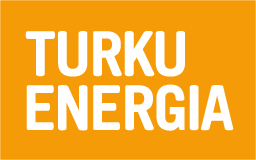Origin of energy
Sustainable Energy
Turku Energia has worked perseveringly to replace fossil fuels with renewable fuels. Our goal is to achieve carbon neutrality in our energy production by the end of 2029. At the end of 2022, 78 per cent of district heat was generated with renewable fuels.
Origin of district heat
The district heating of Turku Energia is mainly produced at the Naantali power plant, the Oriketo bioheat plant and the Kakola heat pump plant, as well as at the Turku Energia Artukainen steam-heat plant owned by our affiliated company, Turun Seudun Energiantuotanto Oy. In addition, Turku Energia procures about five per cent of the total district heat requirement by procuring heat generated through the use of biofuels and waste heat from its co-operation partners and customers. During peak loading times in freezing winters and when there are disturbances in the operation of the base generation plant, the Turku Energia Luolavuori pellet heat plant and oil-fired heating plants are used in addition to the facilities mentioned previously.
As a result of the multi-fuel power plant completed in Naantali in 2017, the use of coal in the energy production of Turku Energia will be replaced by, for example, bioenergy. The majority of biofuels such as wood chips and bark are procured in the local area and by sea transport. The Naantali power plant also incinerates SRF waste, which is non-recyclable commercial and industrial waste. The resulting refined crushed material has excellent calorific value.
In 2022, the specific emissions of district heating in the Turku area were 60 kgCO2 per MWh of energy sold, decreasing 14 per cent from 2021 despite the energy crisis.
All our cooling solutions are entirely renewable, and specific emissions are 0 kgCO2 per MWh of energy sold.
The products Ekotakuu Lämpö (heating), Ekotakuu Jäähdytys (cooling) and Hukkatakuu Lämpö (heat waste) guarantee that the district heating or cooling purchased by the customer is produced in a fully renewable manner. The products are included in the Registry of guarantees of origin for heating and cooling maintained by the Energy Authority.
Fuels for heat procurement in Turku region 2022
Origin of electrical energy 2022
Origin of electrical energy
The distribution of origins was calculated on the basis of the national residual mix reported by the Finnish Energy Authority and the guarantees of origin obtained by Turku Energia. Guarantees of origin are granted for electricity produced from renewable energy sources. This means that guarantees of origin are also a proof to the customer that the electricity is produced from renewable energy sources. The Finnish Energy Authority publishes the residual mix annually in June. The figures are then updated on our website.
The national residual mix of Finland contains electricity generated by fossil fuels and nuclear power as well as its share of the production of renewable electricity, which has not been sold separately with guarantees of origin.
We produce about half of the electricity we sell. Electrical energy is produced in production plants owned by Turku Energia or its affiliated companies, which are the Naantali power plant owned by Turun Seudun Energiantuotanto Oy (TSE), the Svartisen Hydroelectric Power Station, the Kolsin Voima hydro-power plants, and the Suomen Hyötytuuli Oy wind power plants. Turku Energia also has numerous purchase agreements with different power plants, such as the Högsåra wind power farm and Kiskonjoki hydro-power plant.
CO2 emissions from electricity sold by Turku Energia are 29.17 g/kWh on average. The amount of nuclear fuel used in Finland in 2021 was, on average, 0.17 mg/kWh.
Emissions from district heating in the Turku region
(Emissions from the plants of Turku Energia and its affiliated company Turun Seudun Energiatuotanto Oy. Emissions have been calculated using the benefit-sharing method)
